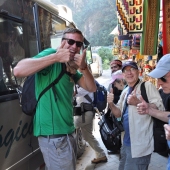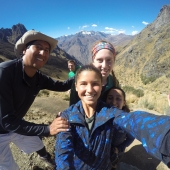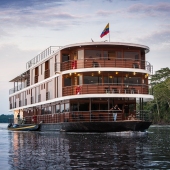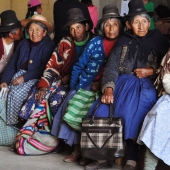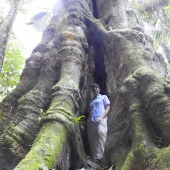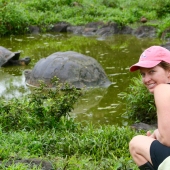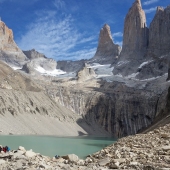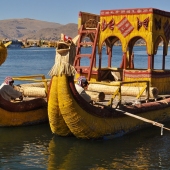
The Questionable Story About The Protests and Closing of Machu Picchu
Written by Vidal Jaquehua. Co-founder and co-owner of Adios Adventure Travel.
You won't see this version of what is happening in Peru in social media accounts or newspapers. It's not what you think. Who is Vidal?
Here's a link to read more about his personal background
Highlights and main topics:
- Machu Picchu Website now open. You can buy your tickets online for entry beginning on Feb 12, 2023.. What do you need to know about traveling to Machu Picchu after protests? CLICK HERE
- IncaRail and Perurail train service is available to book online (Sat Feb 11)
- Why are Indigenous villagers in Peru being threatened with fines if they don't attend protests?
- Why are the vehicles used to transport indigenous people to Cusco covering their license plates?
- Who owns the expensive trucks and jeeps coming from the jungle?
- Who is investigating the Illegal mining and narco-trafficking activities operating unfettered in the jungle for the last 15 months? (and longer)
- Check back. We will keep info updated at the bottom of this report. Scroll down.
- Feb 2. Machu Picchu announced that the cost of entry tickets will increase by 20 soles/ 5 USD as of January 1, 2024. (and you can expect increases at all archaeological sites) However tickets are still not available on the website and the park remains closed.
- Feb 6. Perurail announced that limited train service is being restored beginning Feb 8
- Feb 9. Machu Picchu expected to reopen on February 15. "Big Meeting" between leaders of tourism, mayors of Cusco and the Ministry of Culture came to an agreement. Machu Picchu website still closed at this time. Keep checking. It's a matter of time until tickets will be for sale again.
- Protestors tried to call a 4-day nationwide strike for all workers public and private beginning on Feb 9. The people ignored the call and went to work except at the markets. The leaders of the markets will fine anyone who shows up to work for the next 3 days. This of course, frees up people to attend protests according to Vidal.
- Most roads in Cusco reopened and fuel is coming in. Cusco is starting to return to normal. Local police and residents are clearing rocks and debris to reopen roads and highways. Roads are jammed with cars and trucks now on their way to Cusco. Most roads are open but may still be partially blocked with random hazards remaining from incomplete road clearing.
Geopolitical Information
Our country Peru is in the middle of the Andes Mountain range and the topography of it can be very dramatic. We are by the Pacific sea and have a good portion of the jungle too. This fact means that to develop in this kind of terrain is not easy. And where we have roads, some can be blocked easily.
The capital of Peru is in Lima; and like in any country, a lot of times who ever become to be president will work for the needs of the people that is there. We have over 30% of Peru population in Lima. (over 10 million of people). But the capital is not all the country, they are a lot of cities, including Puno, Arequipa, Cusco, and the ones that are at the southern part..Those are the cityes where protesting has happened lately.
In the last month why have we been having demonstrations and protests all over Peru?
All this did start after the fact the our ex president Castillo has been impeached by the congress, why? Unfortunately, the political situation in our country is not the best. In the last 5 years we had 6 presidents and all of them were impeached by the congress... is this normal? Well,after the changes made in the constitution in 1993, the president can be vacant by the congress due to "temporary or permanent incapacity." ... This last change made that the congress can impeach the president any time.
Castillo a professor of a rural community of our country become to be the hope for all the people that is not in our capital Lima. But in the last 16 months all that was in the news was the fact that the people in power was gettin benefits for them selfs; corruption all over... seems that they had to pay back all the favors that they got to get to the power. Even that Castillo had a good mayority in the congress he was ousted and jailed, people in the sothern area is also part of the country but the current leaders didn't really do much for us, cities like Juliaca doesnt have drinking water, there is no good roads, the health sistem is very poor, we dont have good schools, so ones again generation to generation the leader of the country did fail, and the mess did start.
All this political unrest was saw as a good opportunity for people that work in illegal mining extraction, or people that produce narcotics and groups of the left wing, (Castillos friends) to arrive to the different leaders of the small communities and towns in the mountains to talk them to go and strike. The people in the south has so many needs and they agree that they had to support those leaders. Even though the current president, Dina Boluarte is from the left wing, protestors (Castillos friends) are asking that:
-
the current president should resign
-
a new meeting to do changes in the constitution (asamblea constituyente)
-
to free former Peruvian President Castillo.
To go on a strike is quite common in South America.
To go on a demostration is something that did always happen (is kind ot part of the culture.) But this time has been different. The protestors went a bit far...
Ayacucho, Puno (Juliaca), Arequipa and Cusco airports was on the target of the people that is looking for to create chaos. They did encourage the protestors, so they did try to take over our airport; so some of the most intensive clashes betwin protesters and police officers happen. There is where the people die. Over 40 people that was trying to take over the airports and people that went to take over police stations.. At the same time over 10 people die trying to get to hospitals (because the road blocages, they couldn't make it to the hospitals)
Why are indigenous people participating in protests in Peru?
This kind of behavior in not normal in the people of the mountains..This saturday I went to a small community near Cusco, and i did talk to one of their leaders,Pablo ******, and ask why they went to protest to Cusco. And the answer was that they been obligated to go on the protests by the local governors in place by Castillo, otherwise they had to pay a fine. In Cusco some of the vehicles used for transportation had their license plates covered. Why? People in their comunities are looking for to work. They produce textiles and they would like to sell them to the tourists that goes to their villages. They would like to provide the meals that they do prepare by their own hands.
People in the mountains dont have a lot of incomes to be paying fines, so they went to demostrations; (transportation has been provide. Vidal has a video where the citizens of Cusco were telling the trucks of protestors to go back to their village, "we don't want your violence.") Our people dont throw rocks or go to the airport to take over those constructions. So there is people besides the protestor of the countryside that is causing vandalism and chaos in the city and asking that the current president shoud resign and free Castillo.
On Janury 21 the Peru government did publish an announcement that is all over the world. That Macchu Picchu is closing temporarily in order to protect the safety of tourists and the population in general.
This doesn't mean that the city is close forever. Machu Picchu was closed as a precaution. But people need to work. There are a lot of hotels, restaurants and several tour companies that works in the tourism industry, and at the moment we are on hold, not working thanks to the political unrest due to the fact that the polititians are not lisening to the petitions of the rural areas Today January 24th, a new strike has been announce, (when they announce those strikes everthing freezes.) But the people in the city is tired of those demostrations. Today everything is working normally in Cusco. We have public transportation, the roads are not blocked. Is like a normal regular day. There are still some blokages in the roads of the countryside becasue we do have some people that are still with the ideas of stopping the transportation. But in long term they do realize that everything become to be more expensive, and that the price goes up if the trucks dont arrive to the markets. So their road blockages are slowing down.
Cusco was one of the cities that start a peaceful demostration in order to ask for civility in the streets and went to clean up the road blockages. Everyone dressed in the color white to show they agree this is how we want to move forward. After that we start having less demonstrations... now other cities like Arequipa are doing the same.
After the protests on January 25, some of the main roads were blocked which prevented supply trucks from getting through. Now in Cusco we are having a fuel and propane gas shortage and people are waiting in long lines to buy gas. The cost of propane in Puerto Maldonado in the jungle, has increased around 300%. Propane is essential for cooking. This is the way most families prepare their hot food.
January 26. Arequipa airport resumed flights after being closed for 1 week.
January 28. The roads from Lima to Cusco were unblocked to allow trucks to pass with supplies. Some provinces like Anta are making their own checkpoints to block the trucks. Most citizens are not in favor of the way the protestors are conducting their movement.
January 30. Family owned cooking stalls and dining counters are closed at the San Pedro market in Cusco due to lack of gas for cooking.
The Panamerican Highway south of Ica has been cleared and trucks are movning.
A strike is being organized on Thursday, February 2 and public transportation has agreed to suspend service.
February 1. Congress did not approve the bill for new elections. Organizing new elections was a cornerstone of the movement for change. Some main roads are being opened but Cusco is still without fuel and propane for cooking. No fuel means no trash pickup. Machu Picchu remains closed. Vidal said some local citiznes in Cusco approached the protestors from the villages and asked them why they won't go back to the village. Vidal believes the people from the countryside are being manipulated by their handlers who are telling them what to think. Ex-president Castillo promised to get rid of poverty, and now the indigenous people expect things like municipal services. The people have been told by their "Castillo-appointed" governors that President Dina is the probelm and that she needs to resign. But Vidal believes the problems were there before Dina was sworn into office. The resignation of President Dina is now their mantra. They are fixated on the idea that another new president and a new constitution will somehow make it possible for them to get services that most villages are lacking. Safe drinking water, sewage and electricity. These people are being instructed where to go and what they should do. So they block the roads to places like Puno and Julicaca which chokes off the supply chain from Bolivia. And they block the road to Madre de Dios regions in the jungle. The only part of Peruvian society that benefits from this are the illegal mining, rare wood smuggling, narco-trafficking and contra-band smuggling activities.
Febuary 2. National strike as planned. Ground transport and domestic flights may be interrupted. I did see one flight from Lima to Cusco cancelled today. But others appear to be on schedule. Vidal reported that scarcity of propane in Cusco has led to an increase in the price from 15 soles to 100 soles per tank. Back in Congress, President Dina has refused to resign and the majority of congressional reps are reluctanct to agree to new elections becasue it means they could lose their jobs (honeypots). The fact that Machu Picchu released the announcement about the cost of tickets being increased shows they are still alive. And planning ahead.
February 3. The story is all about the people in Cusco who are standing in long lines to buy propane. For cooking. And the fact that no one is able to work.
February 4. The Madres de Dios region in the Amazon jungle is collapsing into a state of complete anarchy under the rule of protestors who operate like a mafia who control everything. Local law enforcement has been told to stand down. There is no allowance for ambulances or medical services. Blockaded roads prevent the delivery of gas, propane for cooking, ingredients for making things like bread, and essentials like medical supplies. Illegal drugs and other blackmarket products from Brazil and Bolivia, are crossing the border under the complete control of an organized group of protestors. Business owners in Puerto Maldonado are forced to pay a "quota" to remain open, "to support our brothers who went to protest in Lima.". Many businesses are closing. Residents who have small plots where they grow food must pay "toll" to pass. The protestors are in complete control and citizens are on their own. If you want to read more about Puerto Madonado here's a link to a spanish-language article.in El Buho.
February 5. Machupicchu district organizations held a general assembly meeting and decided to temporarily suspend the strike in the district. The measure is partly meant to resolve the problems of supply of products and other items. Vidal says this is because the protestors in Aguas Calientes intend to go to Lima to ask the government to reopen parks, hotels, trains and services for tourism.
February 9. A meeting with tourism officials, Cusco mayors and Ministry of Culture have agreed to reopen Machu Picchu on Feb 9. Roads to Cusco are being cleared by police and local residents to restore supply chain. Vidal was at the market yesterday and a vendor explained that the owner of the market threatened to fine any vendor who opened for the next 4 days. Cusco is starting to go back to normal with most roads open and most local transportation back in operation. Protests are still conducted in small towns and communities but police have cracked down and arrested vandals over the last week. Civil order is coming back in the larger cities.
February 11. The strike fell apart in Cusco. Residents are working. Small groups of protestors can still be found. But there is no national movement to shut down the country any longer.
The road blocks to Madre de Dios region in the jungle have been breeched and trucks are entering with much-needed supplies.
We went through many difficult situations and even this time we won't let the political unrest destroy our country, because we see them. We know what they are doing and we will not allow it. We know that this unrest will be over soon and will have our regular days again. Because that's how most of us working people want it.
with peace and love.
Vidal Jaquehua


